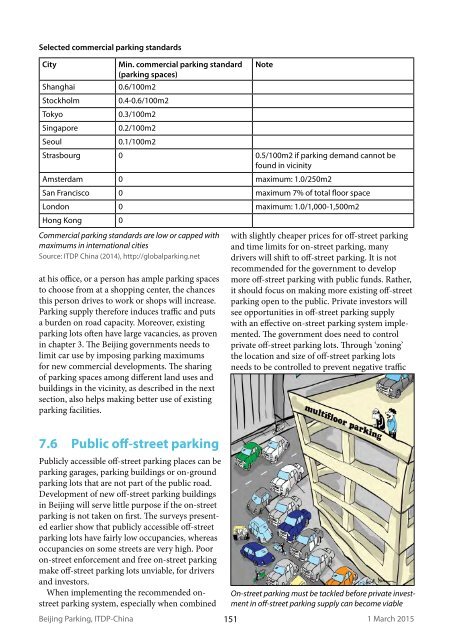Beijing-parking-ITDP-China
Beijing-parking-ITDP-China
Beijing-parking-ITDP-China
Create successful ePaper yourself
Turn your PDF publications into a flip-book with our unique Google optimized e-Paper software.
Selected commercial <strong>parking</strong> standardsCityMin. commercial <strong>parking</strong> standard Note(<strong>parking</strong> spaces)Shanghai0.6/100m2Stockholm0.4-0.6/100m2Tokyo0.3/100m2Singapore0.2/100m2Seoul0.1/100m2Strasbourg 0 0.5/100m2 if <strong>parking</strong> demand cannot befound in vicinityAmsterdam 0 maximum: 1.0/250m2San Francisco 0 maximum 7% of total floor spaceLondon 0 maximum: 1.0/1,000-1,500m2Hong Kong 0Commercial <strong>parking</strong> standards are low or capped withmaximums in international citiesSource: <strong>ITDP</strong> <strong>China</strong> (2014), http://global<strong>parking</strong>.netat his office, or a person has ample <strong>parking</strong> spacesto choose from at a shopping center, the chancesthis person drives to work or shops will increase.Parking supply therefore induces traffic and putsa burden on road capacity. Moreover, existing<strong>parking</strong> lots often have large vacancies, as provenin chapter 3. The <strong>Beijing</strong> governments needs tolimit car use by imposing <strong>parking</strong> maximumsfor new commercial developments. The sharingof <strong>parking</strong> spaces among different land uses andbuildings in the vicinity, as described in the nextsection, also helps making better use of existing<strong>parking</strong> facilities.7.6 Public off-street <strong>parking</strong>Publicly accessible off-street <strong>parking</strong> places can be<strong>parking</strong> garages, <strong>parking</strong> buildings or on-ground<strong>parking</strong> lots that are not part of the public road.Development of new off-street <strong>parking</strong> buildingsin <strong>Beijing</strong> will serve little purpose if the on-street<strong>parking</strong> is not taken on first. The surveys presentedearlier show that publicly accessible off-street<strong>parking</strong> lots have fairly low occupancies, whereasoccupancies on some streets are very high. Pooron-street enforcement and free on-street <strong>parking</strong>make off-street <strong>parking</strong> lots unviable, for driversand investors.When implementing the recommended onstreet<strong>parking</strong> system, especially when combinedwith slightly cheaper prices for off-street <strong>parking</strong>and time limits for on-street <strong>parking</strong>, manydrivers will shift to off-street <strong>parking</strong>. It is notrecommended for the government to developmore off-street <strong>parking</strong> with public funds. Rather,it should focus on making more existing off-street<strong>parking</strong> open to the public. Private investors willsee opportunities in off-street <strong>parking</strong> supplywith an effective on-street <strong>parking</strong> system implemented.The government does need to controlprivate off-street <strong>parking</strong> lots. Through ‘zoning’the location and size of off-street <strong>parking</strong> lotsneeds to be controlled to prevent negative trafficOn-street <strong>parking</strong> must be tackled before private investmentin off-street <strong>parking</strong> supply can become viableTMsfcooProim<strong>Beijing</strong> Parking, <strong>ITDP</strong>-<strong>China</strong> 1511 March 2015


